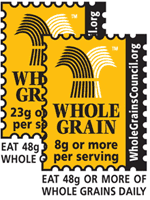Eat Whole Grains to Feel Full, Stay Slim, and Get Healthy

When I heard the words whole grains, the first image that popped into my head was a not-so-pleasant childhood memory of my mom trying to stealthily swap regular spaghetti for whole-wheat. My two sisters and I were not fooled! We shoved our plates away and complained enough that poor mom never thought about serving whole-wheat pasta again.
My connotation of whole grains quickly changed when I attended a conference called “Make (at Least!) Half Your Grains Whole!,” hosted by the Whole Grains Council and the Oldways Food Issues Think Tank. These are the same folks who created the Mediterranean Diet pyramid and who are responsible for the yellow Whole Grains stamp you see on foods at the grocery.
Whole-grain foods—and science—have come a long way since my mom tried that little switcheroo. First, the science: Whole grains are associated with a lower body mass index (BMI) and improved satiety. One Dutch study showed that women’s risk of obesity was four percent lower for every gram of whole grains in their diets. People who eat whole grains also have better blood sugar, lower blood pressure, and lower risks of diabetes and heart failure. The health benefits may come from the extra nutrition—whole grains have fiber, antioxidants, essential fatty acids, and other great-for-you components—or, people who eat whole grains may eat healthier and live healthier lifestyles.

Now, how to get more grains: When you’re shopping, look for the words “whole grain” on the package, or look for the Whole Grains stamp. Don’t worry if the grains have been rolled, cracked, broken, ground, pre-cooked, or crushed. As long as you get all three parts of the grain—the bran, germ, and endosperm—you’re good to go.
Watch out for “degerminated” foods, which have had the germ removed. Also look out for “pearled”—those grains have had the bran removed to make them faster to cook. However, once the bran is removed, they’re not whole grains anymore. (Semi-pearled is okay.)
Nutritionists and the 2005 U.S. Dietary Guidelines also encourage making at least half the grain foods we eat whole-grain foods (that’s at least three servings a day, or about 48 grams). Right now, only 11% of Americans eat whole grains that often.



0 komentar:
Post a Comment